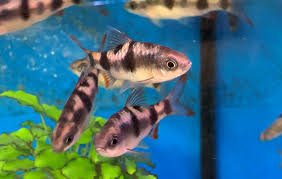 Image 1 of 1
Image 1 of 1


GloFish- Barb Tiger Starfire Red
Here are the requirements for keeping Tiger Barbs (Puntigrus tetrazona):
Aquarium size: Tiger Barbs are active swimmers and should be kept in a tank with a minimum capacity of 20 gallons (75 liters) to provide ample swimming space. A larger tank is recommended for a larger group of Tiger Barbs.
Water parameters: Tiger Barbs can adapt to a wide range of water conditions. The ideal temperature range is around 72-82°F (22-28°C), pH between 6.0-7.5, and hardness between 5-20 dGH. Maintain stable water conditions and avoid drastic fluctuations.
Tank setup: Provide a well-decorated aquarium with plants, rocks, driftwood, and hiding spots. Tiger Barbs appreciate densely planted tanks, but leave open swimming areas in the middle for their active nature. Ensure a secure lid or cover to prevent them from jumping out.
Filtration and water flow: Use a suitable filtration system to maintain good water quality. Tiger Barbs prefer moderate water flow, so choose a filter that provides adequate filtration without creating strong currents. Efficient mechanical, chemical, and biological filtration is important.
Lighting: Provide moderate lighting conditions in the aquarium. Tiger Barbs do not require intense lighting but ensure sufficient light for the growth of live plants if present. Use a lighting system that mimics natural day and night cycles, with a photoperiod of around 8-10 hours of light per day.
Diet: Tiger Barbs are omnivorous and have a preference for small food particles. Offer them a varied diet consisting of high-quality flake or pellet food as their staple. Supplement their diet with occasional live or frozen foods such as bloodworms, brine shrimp, daphnia, or vegetable matter.
Tank mates: Tiger Barbs are social fish and should be kept in a group of at least six individuals. However, they can be fin nippers, especially if kept in small numbers or with long-finned or slow-moving fish. Avoid keeping them with delicate or timid species. Suitable tank mates include other active and similarly sized fish like barbs, danios, rasboras, and some catfish species.
Here are the requirements for keeping Tiger Barbs (Puntigrus tetrazona):
Aquarium size: Tiger Barbs are active swimmers and should be kept in a tank with a minimum capacity of 20 gallons (75 liters) to provide ample swimming space. A larger tank is recommended for a larger group of Tiger Barbs.
Water parameters: Tiger Barbs can adapt to a wide range of water conditions. The ideal temperature range is around 72-82°F (22-28°C), pH between 6.0-7.5, and hardness between 5-20 dGH. Maintain stable water conditions and avoid drastic fluctuations.
Tank setup: Provide a well-decorated aquarium with plants, rocks, driftwood, and hiding spots. Tiger Barbs appreciate densely planted tanks, but leave open swimming areas in the middle for their active nature. Ensure a secure lid or cover to prevent them from jumping out.
Filtration and water flow: Use a suitable filtration system to maintain good water quality. Tiger Barbs prefer moderate water flow, so choose a filter that provides adequate filtration without creating strong currents. Efficient mechanical, chemical, and biological filtration is important.
Lighting: Provide moderate lighting conditions in the aquarium. Tiger Barbs do not require intense lighting but ensure sufficient light for the growth of live plants if present. Use a lighting system that mimics natural day and night cycles, with a photoperiod of around 8-10 hours of light per day.
Diet: Tiger Barbs are omnivorous and have a preference for small food particles. Offer them a varied diet consisting of high-quality flake or pellet food as their staple. Supplement their diet with occasional live or frozen foods such as bloodworms, brine shrimp, daphnia, or vegetable matter.
Tank mates: Tiger Barbs are social fish and should be kept in a group of at least six individuals. However, they can be fin nippers, especially if kept in small numbers or with long-finned or slow-moving fish. Avoid keeping them with delicate or timid species. Suitable tank mates include other active and similarly sized fish like barbs, danios, rasboras, and some catfish species.






